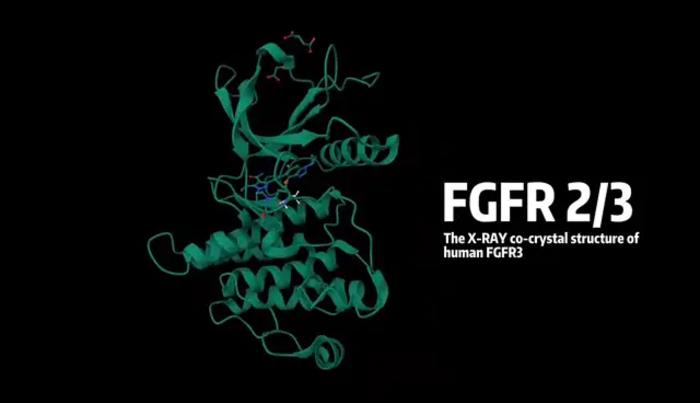In the relentless pursuit of precision oncology, researchers at Insilico Medicine have unveiled a groundbreaking strategy to develop highly selective inhibitors targeting fibroblast growth factor receptors FGFR2 and FGFR3. These receptors, often implicated as pivotal drivers in a range of malignancies including intrahepatic cholangiocarcinoma, endometrial, breast, gastric, and bladder cancers, have posed enormous drug development challenges due to their close structural kinship with other FGFR family members. The new approach masterfully employs advanced molecular modeling integrated with a proprietary artificial intelligence platform to sidestep the pitfalls of off-target effects that have beleaguered existing FGFR inhibitors.
FGFR-targeted therapies have historically suffered from limited specificity, particularly because the kinase domains of FGFR1, FGFR2, and FGFR3 share over 95% homology within their ATP-binding pockets. This formidable similarity renders the development of selective drugs exceedingly difficult, often leading to pan-FGFR inhibitors that inadvertently suppress FGFR1 and FGFR4 activity. Such broad inhibition results in dose-limiting toxicities, notably hyperphosphatemia and gastrointestinal disturbances, which curtail therapeutic benefit and patient tolerability. Moreover, the clinical efficacy of current FGFR inhibitors is further compromised by emerging resistance mutations predominantly within FGFR2 and FGFR3, underlining the urgent need for next-generation selective inhibitors.
The Insilico team embarked on a rational drug design campaign leveraging their Chemistry42 AI-driven molecular design platform. Initial steps involved meticulous structural analysis which highlighted the kinase hinge region, referred to as core A, as the crucial site for selective ligand engagement. Employing these insights, a pharmacophore model was constructed emphasizing essential hydrogen bond donors and acceptors, while simultaneously incorporating spatial features predictive of selectivity and potency toward FGFR2/3 over other family members. This foundational model laid the groundwork for deep chemical space exploration.
Capitalizing on the generative capabilities of Chemistry42, researchers synthesized an extensive virtual library exceeding 10,000 candidate molecules featuring diverse heterocyclic cores and linkers. Rigorous in silico screening employed the protein-ligand interaction (PLI) scoring function, designed to quantify predicted binding affinities and interaction quality within the kinase domain. This scoring paradigm, alongside filters for drug-like physicochemical properties, enabled the identification of promising scaffolds potentially capable of overcoming resistance mutations by displaying binding flexibility in the hinge region.
Among the top candidates emerged a unique amide-based scaffold, designated core3 (C3), which demonstrated superior predicted selectivity and potency profiles. The adaptive binding characteristics of the C3 core suggested an enhanced capacity to tolerate conformational changes induced by mutant variants of FGFR2/3, a key advantage in circumventing acquired drug resistance. Subsequent computational refinement involved ADMET (absorption, distribution, metabolism, excretion, and toxicity) profiling and rigorous free energy perturbation calculations via Chemistry42’s Alchemistry module, refining the molecular candidates for optimized binding thermodynamics and favorable pharmacokinetics.
The computationally designed molecule ISM7594 embodies the culmination of these efforts—a covalent dual inhibitor with structural innovations centered on a distinctive hinge-binding motif and the novel C3 core. In vitro characterization revealed nanomolar inhibitory potency against both FGFR2 and FGFR3 kinases, paired with an extraordinary selectivity margin exceeding 100-fold relative to FGFR1 and FGFR4 isoforms. Crucially, ISM7594 maintained robust inhibitory activity against clinically relevant FGFR2/3 mutants that commonly drive resistance to existing treatments.
Functional cellular assays underscored the antiproliferative efficacy of ISM7594 in cancer cell lines harboring pathologic FGFR2/3 alterations, while exhibiting minimal cytotoxicity in cells lacking receptor aberrations. These results point to a therapeutic window that could maximize tumor targeting while sparing normal tissues. Furthermore, preclinical animal models demonstrated that ISM7594 yields significant tumor growth suppression with a markedly improved safety profile compared to currently approved pan-FGFR inhibitors, reinforcing its potential clinical value.
This pioneering study, published in the Journal of Medicinal Chemistry, not only exemplifies the power of AI-augmented drug design but also affirms the pivotal role of integrative computational-experimental workflows in expediting the discovery of precision medicines. Dr. Xiao Ding, Head of Chemistry & DMPK and Senior Vice President of Medicinal Chemistry at Insilico Medicine, emphasized the synergy of computational innovation and experimental validation as critical to translating in silico hypotheses into tangible therapeutic candidates.
The research advances beyond the initial discovery phase; in early 2025, Insilico detailed further structure-activity relationship explorations through the discovery of pyrrolopyrazine carboxamide derivatives exhibiting enhanced selectivity and mutant resistance profiles. This iterative optimization reflects the dynamic capabilities of the Chemistry42 platform to not only generate but rapidly refine drug-like molecules through successive design cycles.
Since its inception in 2014, Insilico Medicine has grown into a leading clinical-stage AI biotechnology company, consistently propelling the frontiers of drug discovery by fusing deep generative modeling with reinforcement learning and transformer architectures. Their innovative platforms enable holistic approaches spanning novel target identification, molecular generation, and predictive modeling of pharmacodynamics and pharmacokinetics. This confluence of biology, chemistry, and cutting-edge AI has positioned Insilico among the top global institutions contributing to biological and natural sciences, underscoring their influence on the future landscape of precision medicine.
The successful design and validation of ISM7594 highlight a compelling paradigm shift—where artificial intelligence becomes an indispensable partner in the rational creation of highly selective therapeutics capable of addressing complex challenges such as target homology and drug resistance. This breakthrough heralds a new era in cancer treatment development, promising safer, more effective interventions tailored to molecular vulnerabilities with unprecedented speed and precision.
Subject of Research: Development of selective FGFR2/3 inhibitors overcoming resistance mutations in cancer therapy
Article Title: Rational Design and Identification of ISM7594 as a Tissue-Agnostic FGFR2/3 Inhibitor
News Publication Date: 25-Jun-2025
Web References:
https://doi.org/10.1021/acs.jmedchem.5c00928
https://insilico.com/
References:
[1] Wang, Y. et al. (2025) ‘Rational design and identification of ISM7594 as a Tissue-Agnostic FGFR2/3 inhibitor,’ Journal of Medicinal Chemistry [Preprint]. https://doi.org/10.1021/acs.jmedchem.5c00928
Image Credits: Insilico Medicine
Keywords
Pharmaceuticals, Fibroblast Growth Factor Receptors, FGFR2/3 Inhibitors, Cancer Therapy, AI-Driven Drug Design, Molecular Modeling, Chemistry42, Drug Resistance, Kinase Inhibitors, Precision Medicine, Medicinal Chemistry




